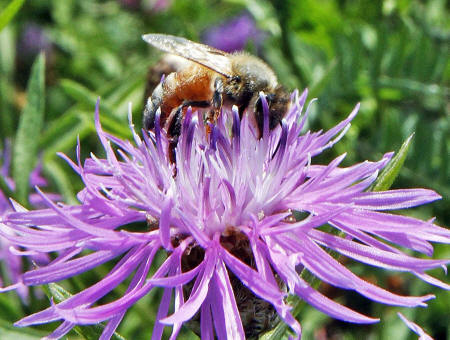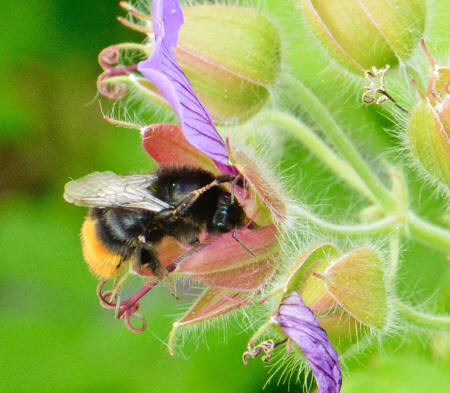|
from
WashingtonPost Website
A bee alights on the bloom of a thistle in Berlin, Vt.
(AP Photo/Toby
Talbot)
An increasing number of pollinator
species are thought to be in decline, threatened by a variety of
mostly human pressures, and their struggles could pose significant
risks for global food security and public health.
But this week, a United Nations organization has released the first-ever global assessment of pollinators, highlighting their importance for worldwide food and nutrition, describing the threats they currently face and outlining strategies to protect them.
The report, which was released Friday by the U.N.'s Intergovernmental Science-Policy Platform on Biodiversity and Ecosystem Services (IPBES), has been in the works since the summer of 2014.
The research team consisted of more than 70 experts, who drew on the most up-to-date global pollinator science, as well as local and indigenous knowledge, to complete the assessment.
The report includes four overarching findings, said Simon Potts, deputy director of the Center for Agri-Environmental Research at Reading University, during a Friday press briefing.
The importance of pollinators
The health of pollinator populations is intrinsically tied up with global food security, the IPBES assessment notes.
Altogether, nearly 90 percent of all flowering plants on Earth depend on animal pollination, and that includes about 75 percent of the world's food crops.
Keeping agricultural production high enough to feed the world's ballooning human populations will depend in a big way on the insects and other animals that help them reproduce.
The assessment reports that in the past 50 years alone, the volume of agricultural production that depends on animal pollination has increased by about 300 percent.
Some of the most widely enjoyed crops that heavily depend on animal pollination include,
And pollinators' importance to agriculture means there's a big economic factor to consider there as well.
The assessment finds that anywhere from $235 billion to $577 billion worth of global food production every year relies on animal pollination.
Additionally, many pollinator species have immense social and cultural value, Vera Imperatriz-Fonseca, co-chair of the assessment and an ecology professor at the University of Sao Paulo in Brazil, said at the briefing.
She pointed out that many are,
So there are clear reasons to care about the fate of the world's pollinators.
The problem is that in many places, they aren't doing so well.
Using data from the International Union for Conservation of Nature's Red List of Threatened Species, the IPBES assessment points out that more than 16 percent of vertebrate pollinators on Earth - that's mainly bats and birds - are threatened with extinction.
Insects are a little harder to assess because there tends to be less global data about them.
But regional studies have shown widespread declines throughout many parts of the world, especially among bees and butterflies.
He also added that there's been only one continental assessment conducted, which studied bees and butterflies in Europe and found that 9 percent were threatened.
Even this number is likely an underestimate, he added, given that approximately half the bee species on the continent could not be assessed due to a lack of data.
The declines are a concern for both wild pollinators and managed ones, which are kept by humans, the researchers are careful to note. Honeybees are the most common managed pollinators.
And while overall the number of honeybee hives throughout the world has doubled in the last 50 years, certain regions - most notably Europe and North America - have experienced significant declines as a result of colony collapse disorder.
What's threatening the pollinators - and how can we help them?
According to the assessment, there are a wide variety of factors affecting pollinators throughout the world, and it would be difficult to pinpoint one primary source of all the trouble.
Habitat destruction and degradation is one important source. Some species of pollinators can visit just about any type of plant they want - but others are much more specialized, and only feed on certain species.
So having a high diversity of plants in any given area is important for attracting many different types of pollinators. Developing the land and cutting down on the natural plant diversity in an area can be a big problem.
Intensive agriculture, which focuses on only a few crops at a time, can be a contributor to this issue. And the use of pesticides has demonstrated harmful effects as well - an issue that's recently come to the forefront of national attention in the United States.
The Obama administration's National Strategy to Promote the Health of Honey Bees and Other Pollinators, released by the White House last year, called for better scrutiny of the effects of pesticides on pollinating insects.
And last month, the Environmental Protection Agency released the first in a series of preliminary risk assessments of insecticides thought to be harmful to bees. The U.N.'s assessment notes that the effects of pesticides depend on the type of chemical being used, the amount in which it's applied and the type of pollinator that's been exposed. However, the assessment does report that research has found a variety of lethal and nonlethal (but still negative) consequences of pesticide exposure in insect pollinators, mainly bees.
During Friday's press briefing, the authors were quick to clarify that the report is not meant to be taken as a blanket condemnation of pesticide use.
Other factors thought to be affecting pollinators include disease and the influence of invasive species, which can compete with native species for resources. And climate change is becoming a growing concern, as well.
Many species have already been affected by the changing climate, said Jeremy Kerr, a biology professor at the University of Ottawa, who was not an author on the new assessment.
Last year, Kerr was the lead author on a study (Climate Change Impacts on Bumblebees Converge Across Continents) published in Science which found that bumblebees in both North America and Europe have been shifting their ranges in response to climate change.
This kind of reaction is a concern because there's a possibility that, over time, pollinators could shift their ranges out of reach of the plants they usually pollinate.
And this is just one effect we'll likely continue to see in the future.
Climate change can cause some species to emerge at different times of the year than they used to, for instance, or reproduce at different times.
These kinds of changes could disrupt their seasonal interactions with the plants they pollinate.
With so many factors threatening the world's pollinators, the looming question is whether anything can be done to save them.
According to the new assessment, there are actually a lot of opportunities on this front. Protecting natural areas and diversifying the landscape are obvious steps.
The assessment suggests restoring native vegetation, planting flower corridors and trying to keep natural areas connected to one another as much as possible.
The assessment also recommends more diverse and sustainable forms of agriculture - for example,
More in-depth research will be necessary for a better understanding of the specific effects of individual pesticides, and governments may also consider coming up with strategies to reduce their pesticide use and develop more diverse pest management techniques, the assessment suggests.
And taking steps to,
...are all crucial, as well.
The biggest takeaway is that there are a huge variety of threats facing the world's pollinators, and so proportional action must be taken to address each of them as soon as possible.
The answer remains to be seen, and will likely depend on the coordinated actions of individual governments.
But there's much to be optimistic about, according to the assessment's authors. The report was agreed upon by the more than 100 countries belonging to IPBES, which demonstrates an international concern for the issue, they pointed out at Friday's briefing.
The role of IPBES, and its report, is to strengthen the dialogue between the scientific community and policymakers, said IPBES chair Zakri Abdul Hamid.
|



